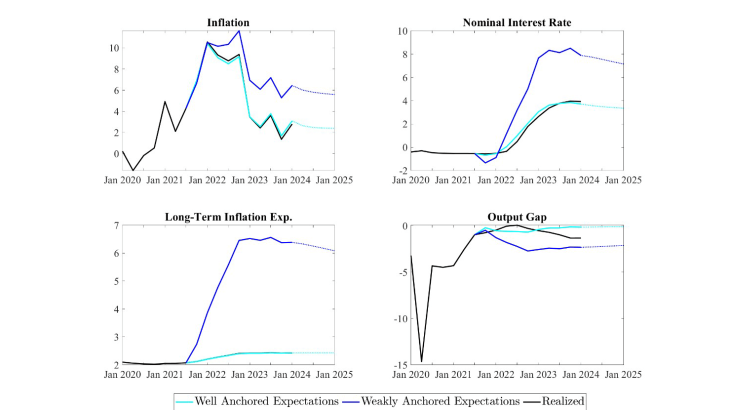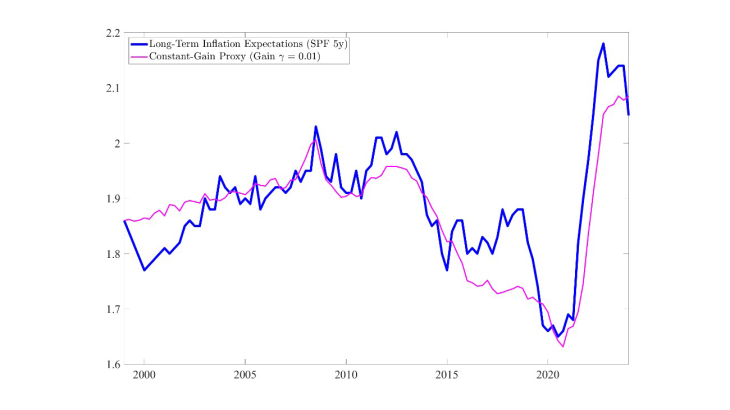Post No. 396. Relative to the inflation of the 1970s, inflation expectations were much better anchored during the inflation surge of recent years due to central banks’ greater credibility. This blog post provides model counterfactuals showing that euro area inflation would have been higher for longer, had inflation expectations been as poorly anchored as in the 1970s.
Chart 1: Counterfactual under less well-anchored expectations

Well-anchored expectations: an invisible contribution of monetary policy
In 2021-23, the world economy experienced supply shocks and inflation levels of magnitudes not seen since the 1970s. Central banks responded with policy decisions of magnitudes equally unseen in several decades. Between July 2022 and September 2023, the ECB hiked its policy rates by 450 basis points, the fastest increase since its inception. According to Lhuissier (2025)’s estimates, this lowered inflation by 2.5 to 3 percentage points in 2024.
This estimate, however, only accounts for part of the contribution of monetary policy to lower inflation. It measures the contribution of the monetary policy decisions taken from 2021 onwards, assuming that inflation expectations would have remained well-anchored even if the ECB had not reacted at all. Yet, well-anchored inflation expectations (Burban et al., 2024) were the result of previous decades of low and stable inflation, an environment that central banks delivered thanks to central bank independence, greater transparency and communication, and a commitment to price stability (Bignon and Gautier, 2023). The good track record of their past policies allowed them to maintain well-anchored expectations, an asset that proved very important in dampening the effect of the large supply shocks of 2021-23.
Learning gain as a measure of expectations anchoring
A common assumption on the way households and firms form expectations is to assume that they try to learn what inflation will be from what it has been in the past. Under this assumption, households and firms increase their inflation expectations whenever inflation turns out higher than expected. But they may increase them by a little or by a lot. A simple way to measure how well long-term inflation expectations are anchored is to estimate how much they increase with recently realised inflation.
This can be measured by the learning gain, which may be assumed to be constant over time (the assumption of constant-gain learning). Under a low learning gain, long-term inflation expectations depend little on the very recent realisations of inflation. Instead, they depend mostly on what inflation has been over a long period of time: expectations are well-anchored. Under a high learning gain, long-term inflation expectations depend heavily on the recent realisations of inflation, and the more distant past is quickly forgotten. Expectations are poorly anchored. A good track record of the central bank can deliver not only low inflation but also a low learning gain, guaranteeing that a short-lived burst of inflation has a limited effect on long-term inflation expectations.
Since the inception of the euro area, the learning gain is estimated to be small. Using the 5-year-ahead average inflation expectations from the Survey of Professional Forecasters (SPF) over 1999-2024, we find a quarterly gain of 0.01. This means that if inflation in a given quarter is one percentage point higher than expected, professional forecasters increase their inflation expectations by one basis point on average. Chart 2 shows how estimated long-term inflation expectations with a learning gain of 0.01 tracks the average 5-year-ahead inflation expectations of the SPF.
Chart 2: Long-run inflation expectations in the euro area

However, there is no guarantee that a low gain will remain low forever. If the low gain is not based on a track record of commitment to price stability, or if firms and households start to question this commitment, large inflationary shocks can make firms and households switch to a higher gain. Carvalho et al. (2023) argue that this is what happened in the 1970s. They estimate that firms and households switched to a high quarterly gain of 0.145.
Counterfactuals had expectations been less well-anchored
How much higher would inflation have been if inflation expectations had been less well-anchored? How much more would the ECB have had to increase its policy rate? And how much lower would GDP have been? To answer these questions, we provide counterfactuals building on Dupraz and Marx (2024), itself based on the model of Woodford (2019). The paper analyses monetary policy in a set-up where household and firms form long-term inflation expectations through constant gain learning. This contrasts with much of the literature on monetary policy which, by relying on rational expectations, assumes that long-term inflation expectations always remain perfectly on target. As such, our counterfactuals capture the contribution of well-anchored expectations, something absent in other model-based estimates of the contribution of monetary policy (e.g. Lane 2024).
Chart 1 provides the results. The realised paths of the output gap (as measured by the European Commission), HICP inflation and the ECB policy rate are shown in black. The model's optimal policy recommendation is shown in light blue, starting from Q3 2021 and assuming that the learning gain is at its estimated value of 0.01. The optimal policy depends on the central bank’s preferences, which we calibrate to approximately replicate the realised path of the policy rate. Hence, the optimal policy recommendations are close to their realised values by design.
The dark blue line shows the optimal policy recommendation in the counterfactual where, starting from Q3 2021, firms and households would have switched to the much higher learning gain of 0.145. The model finds that inflation would have been significantly higher, with +1.4pp in 2022, and +3.5pp in 2023, due to a significant increase of long-run inflation expectations. The ECB would have increased its policy rate much more, to a peak of 8.5% instead of 4%. And output would as a result have been lower, by -1.4pp in 2022, and -2.2pp in 2023.
An important but invisible contribution of monetary policy during the 2021-23 inflation surge was therefore to ensure that households and firms’ inflation expectations remained well-anchored. The ECB’s credibility to keep them anchored was earned in large part before the shocks of 2021-23 even hit, through its prior track record of keeping inflation close to target. Nevertheless, decisive action in response to the initial inflation surge was still needed to sustain this credibility and it could have been quickly lost had the ECB’s determination been questioned. These decisive actions will also have a lasting benefit by contributing to keeping inflation expectations anchored in the future.
Download the full publication
Updated on the 20th of March 2025